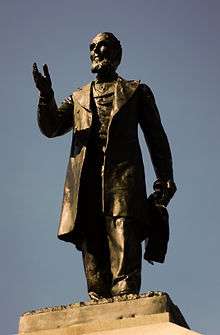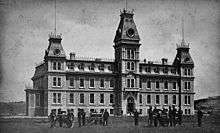Alexander Mackenzie (politician)
| The Honourable Alexander Mackenzie PC | |
|---|---|
 | |
| 2nd Prime Minister of Canada | |
|
In office November 7, 1873 – October 8, 1878 | |
| Monarch | Victoria |
| Governor-General | The Earl of Dufferin |
| Preceded by | John A. Macdonald |
| Succeeded by | John A. Macdonald |
| Member of the Canadian Parliament for Lambton | |
|
In office September 20, 1867 – June 20, 1882 | |
| Preceded by | District created upon Confederation |
| Succeeded by | District abolished |
| Member of the Canadian Parliament for York East | |
|
In office June 20, 1882 – April 17, 1892 | |
| Preceded by | Alfred Boultbee |
| Succeeded by | William Findlay Maclean |
| Personal details | |
| Born |
January 28, 1822 Logierait, Atholl, Perthshire, Scotland, UK |
| Died |
April 17, 1892 (aged 70) Toronto, Ontario, Canada |
| Cause of death | Stroke from a fall by hitting his head |
| Resting place | Lakeview Cemetery, Sarnia, Ontario |
| Political party | Liberal |
| Spouse(s) |
Helen Neil (m. 1845; her death 1852) Jane Sym (m. 1853; his death 1892) |
| Children | 3 |
| Religion |
Baptist (Previously Presbyterian) |
| Signature |
 |
| Military service | |
| Allegiance |
|
| Service/branch | Canadian Army |
| Years of service | 1866–1874 |
| Rank |
|
Alexander Mackenzie (PC; January 28, 1822 – April 17, 1892), was a building contractor and newspaper editor, and was the second Prime Minister of Canada, from November 7, 1873 to October 8, 1878.
Life and career
Mackenzie was born in Logierait, Perthshire, Scotland, the son of Mary Stewart (Fleming) and Alexander Mackenzie. He was the third of ten children. At the age of 13, Mackenzie's father died, and he was forced to end his formal education in order to help support his family. At the age of 20 he apprenticed as a stonemason and immigrated to Canada in 1842 to seek a better life as well as to follow his sweetheart, Helen Neil. Shortly thereafter, he converted from Presbyterianism to Baptist beliefs. Mackenzie's faith was to link him to the increasingly influential temperance cause, particularly strong in Canada West where he lived, a constituency of which he was to represent in the Parliament of Canada by age 20 Mackenzie married Helen Neil (1826–52) in 1845 and with her had three children, with only one girl surviving infancy. In 1853, he married Jane Sym (1825–93).

In Canada, Mackenzie continued his career as a stonemason, building many structures that still stand today. He began working as a general contractor, earning a reputation for being a hard working, honest man as well as having a working man's view on fiscal policy.
Mackenzie involved himself in politics almost from the moment he arrived in Canada. He campaigned relentlessly for George Brown, owner of the Reformist paper The Globe in the 1851 election, helping him to win a seat in the assembly. In 1852 Mackenzie became editor of another reformist paper, the Lambton Shield. As editor, Mackenzie was perhaps a little too vocal, leading the paper to a suit of law for libel against the local conservative candidate. The paper lost the suit and was forced to fold due to financial hardship. Mackenzie was elected to the Legislative Assembly as a supporter of George Brown in 1861.
Prime Minister (1873–1878)
When the Macdonald government fell due to the Pacific Scandal in 1873, the Governor General, Lord Dufferin, called upon Mackenzie, who had been chosen as the leader of the Liberal Party a few months earlier, to form a new government. Mackenzie formed a government and asked the Governor General to call an election for January 1874. The Liberals won, having garnered 53.8% of the popular vote. The voter support of 53.8% remains the record in Canada for all federal elections.[1] Mackenzie remained prime minister until the 1878 election when Macdonald's Conservatives returned to power with a majority government.
It was unusual for a man of Mackenzie's humble origins to attain such a position in an age which generally offered such opportunity only to the privileged. Lord Dufferin, the current Governor General, expressed early misgivings about a stonemason taking over government. But on meeting Mackenzie, Dufferin revised his opinions:
"However narrow and inexperienced Mackenzie may be, I imagine he is a thoroughly upright, well-principled, and well-meaning man."
Mackenzie also served as Minister of Public Works and oversaw the completion of the Parliament Buildings. While drawing up the plans, he included a circular staircase leading directly from his office to the outside of the building which allowed him to escape the patronage-seekers waiting for him in his ante-chamber. Proving Dufferin's reflections on his character to be true, Mackenzie disliked intensely the patronage inherent in politics. Nevertheless, he found it a necessary evil in order to maintain party unity and ensure the loyalty of his fellow Liberals.

In keeping with his democratic ideals, Mackenzie refused the offer of a knighthood three times, and was thus the only one of Canada's first eight Prime Ministers not to be knighted. His pride in his working class origins never left him. Once, while touring Fort Henry as prime minister, he asked the soldier accompanying him if he knew the thickness of the wall beside them. The embarrassed escort confessed that he didn't and Mackenzie replied, "I do. It is five feet, ten inches. I know, because I built it myself!"[2]
As Prime Minister, Alexander Mackenzie strove to reform and simplify the machinery of government. He introduced the secret ballot; advised the creation of the Supreme Court of Canada; the establishment of the Royal Military College of Canada in Kingston in 1874; the creation of the Office of the Auditor General in 1878; and struggled to continue progress on the national railway.
However, his term was marked by economic depression that had grown out of the Panic of 1873, which Mackenzie's government was unable to alleviate. In 1874, Mackenzie negotiated a new free trade agreement with the United States, eliminating the high protective tariffs on Canadian goods in US markets. However, this action did not bolster the economy, and construction of the CPR slowed drastically due to lack of funding. In 1876 the Conservative opposition announced a National Policy of protective tariffs, which resonated with voters. When an election was held at the conclusion of Mackenzie's five-year term, the Conservatives were swept back into office in a landslide victory.
After his government's defeat, Mackenzie remained Leader of the Opposition for another two years, until 1880. He remained an MP until his death in 1892 from a stroke that resulted from hitting his head during a fall. He died in Toronto and was buried in Lakeview Cemetery in Sarnia, Ontario.[3]
In their 1999 study of the Prime Ministers of Canada, which included the results of a survey of Canadian historians, J.L. Granatstein and Norman Hillmer found that Mackenzie was in the No. 11 place just after John Sparrow David Thompson.[4]
Namesakes

The following are named in honour of Alexander Mackenzie:
- The Mackenzie Mountain Range in the Yukon & Northwest Territories.
- The Mackenzie building, and the use of the Mackenzie tartan by the bands at the Royal Military College of Canada in Kingston, Ontario. 'Alexander Mackenzie', the Royal Military College of Canada March for bagpipes, was composed in his honour by Pipe Major Don M. Carrigan, who was the College Pipe Major 1973 to 1985.[5]
- Mackenzie Hall in Windsor, Ontario.
- Alexander Mackenzie Scholarships in Economics and Political Science at McGill University
- Alexander MacKenzie Park in Sarnia, Ontario.
- Alexander Mackenzie High School in Sarnia, Ontario.
- Alexander MacKenzie Housing Co-Operative Inc. in Sarnia, Ontario.
Legacy
- A monument is dedicated to his tomb in Lakeview Cemetery, Sarnia, Ontario
- "Honourable Alexander Mackenzie" (1964) by Lawren Harris, head of the Department of Fine Arts, Mount Allison University now hangs in the Mackenzie Building, Royal Military College of Canada. The unveiling ceremony was performed by the Right Honourable Louis St. Laurent, a former Canadian Prime Minister, and the gift was accepted by the Commandant, Air Commodore L.J. Birchall. The painting was commissioned in memory of No. 244, Lieut.-Col, F.B, Wilson, O.B.E, her deceased husband, by Mrs, F.W. Dashwood. Also taking part in the ceremony was the Honourable Paul Hellyer, Minister of National Defence, President and Chancellor of the College.[6]
Supreme Court appointments

Mackenzie chose the following jurists to be appointed as justices of the Supreme Court of Canada by the Governor General:
- Sir William Buell Richards (Chief Justice) – September 30, 1875
- Télesphore Fournier – September 30, 1875
- William Alexander Henry – September 30, 1875
- Sir William Johnstone Ritchie – September 30, 1875
- Sir Samuel Henry Strong – September 30, 1875
- Jean-Thomas Taschereau – September 30, 1875
- Sir Henri Elzéar Taschereau – October 7, 1878
See also
References
- ↑ Éric Grenier, "Size of Justin Trudeau's government breaks records, for better and worse Biggest seat gains in Canada's history delivered a majority government — with one of its smallest mandates" (Dec 2 2015): <http://www.cbc.ca/news/politics/grenier-historical-trudeau-government-1.3344130>.
- ↑ Canada's Prime Ministers, 1867 – 1994: Biographies and Anecdotes. [Ottawa]: National Archives of Canada, [1994]. 40 p.
- ↑ "Historic Sites and Monuments Board of Canada – Former Prime Ministers and Their Grave Sites – The Honourable Alexander Mackenzie". Parks Canada. Government of Canada. December 20, 2010. Retrieved March 5, 2014.
- ↑ Hillmer, Norman; Granatstein, J. L. "Historians rank the BEST AND WORST Canadian Prime Ministers". Diefenbaker Web. Maclean's. Retrieved March 27, 2012.
- ↑ Archie Cairns – Bk1 Pipe Music 'Alexander Mackenzie' (Slow March) by Pipe Major Don M. Carrigan 1995
- ↑ Source: Royal Military College of Canada – Review Yearbook (Kingston, Ontario Canada) Class of 1965page 191
Further reading
- J.L. Granatstein and Norman Hillmer Prime Ministers: Ranking Canada's Leaders. Toronto: Harper Collins Publishers Ltd, A Phyllis Bruce Book, 1999. P. 29 – 36. ISBN 0-00-200027-X.
- Dale C. Thomson Alexander Mackenzie, Clear Grit, 1960. 14960, Macmillan of Canada, 436 pages
External links
- Photograph:Alexander Mackenzie, 1874 – McCord Museum
| Wikimedia Commons has media related to Alexander Mackenzie (politician). |
| Wikisource has original works written by or about: Alexander Mackenzie (politician) |
| Wikiquote has quotations related to: Alexander Mackenzie (politician) |
- "Alexander Mackenzie". Dictionary of Canadian Biography (online ed.). University of Toronto Press. 1979–2016.
- Alexander Mackenzie (politician) – Parliament of Canada biography
| Party political offices | ||
|---|---|---|
| Preceded by George Brown |
Leader of the Liberal Party of Canada 1873–1880 |
Succeeded by Edward Blake |
| Political offices | ||
| Vacant | Leader of the Opposition 1873 |
Succeeded by Sir John A. Macdonald |
| Preceded by Sir John A. Macdonald |
Prime Minister of Canada 1873–1878 | |
| Preceded by Hector Louis Langevin |
Minister of Public Works 1873 – 1878 |
Succeeded by Charles Tupper |
| Preceded by Sir John A. Macdonald |
Leader of the Opposition 1878–1880 |
Succeeded by Edward Blake |
| Parliament of Canada | ||
| Preceded by district created |
Member of Parliament for Lambton 1867 – 1882 |
Succeeded by district abolished |
| Preceded by Alfred Boultbee |
Member of Parliament for York East 1882 – 1892 |
Succeeded by William Findlay Maclean |
